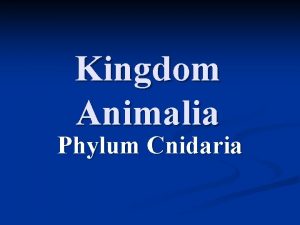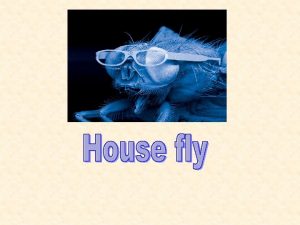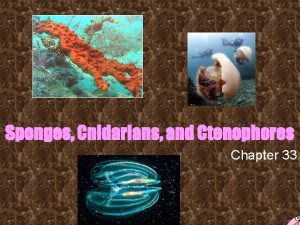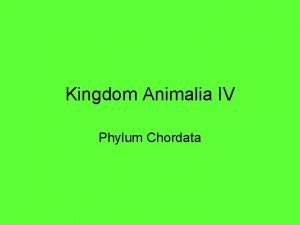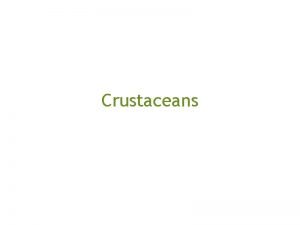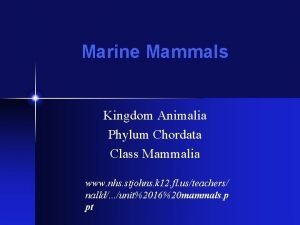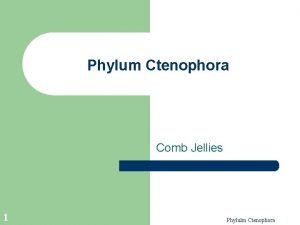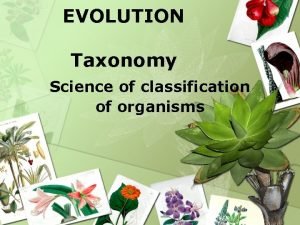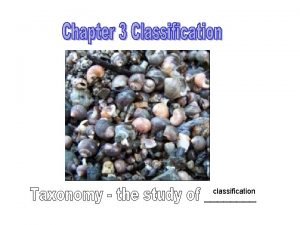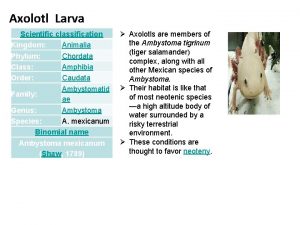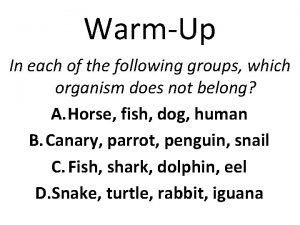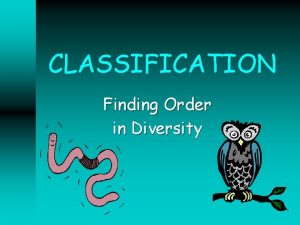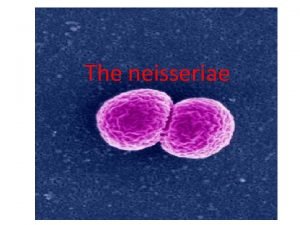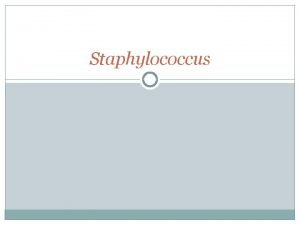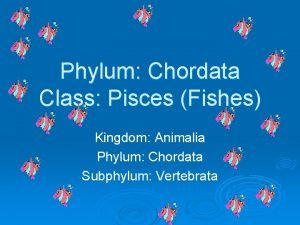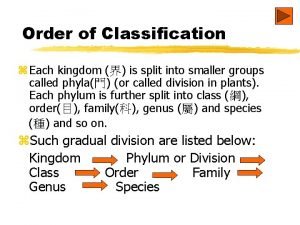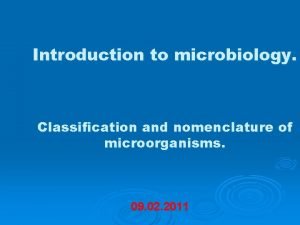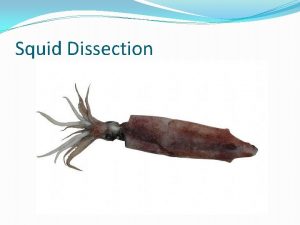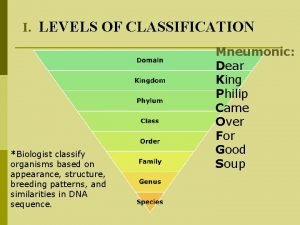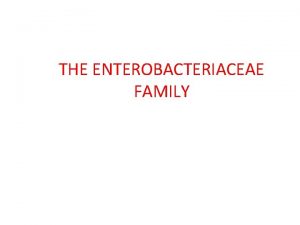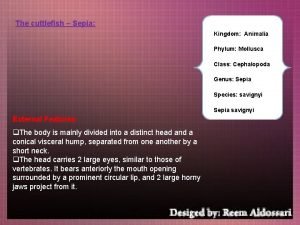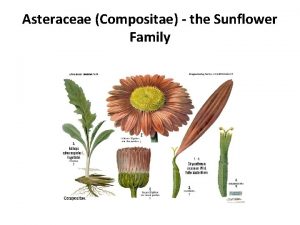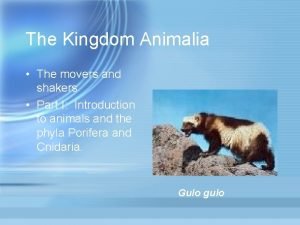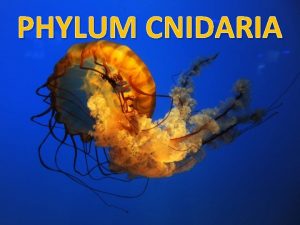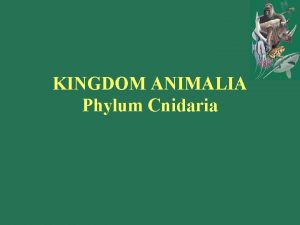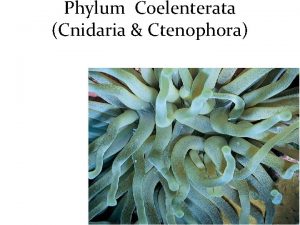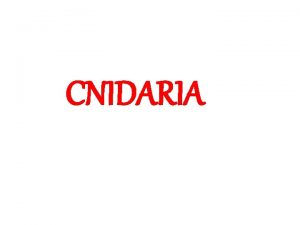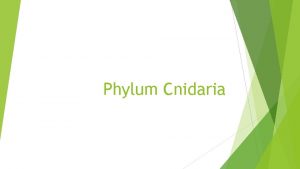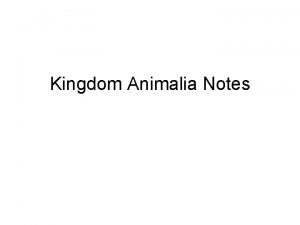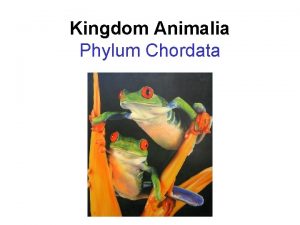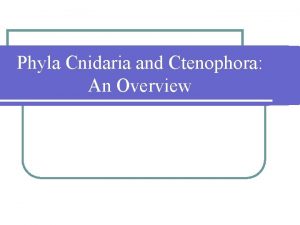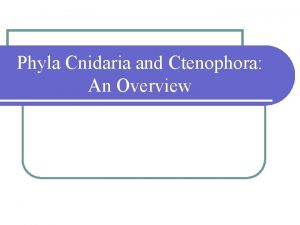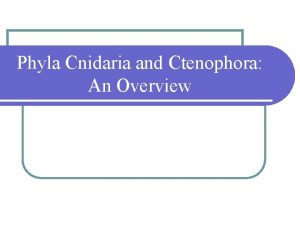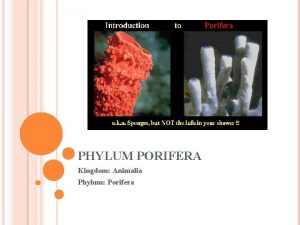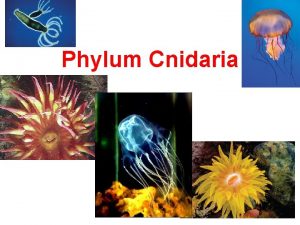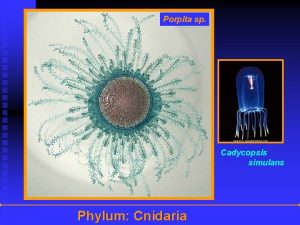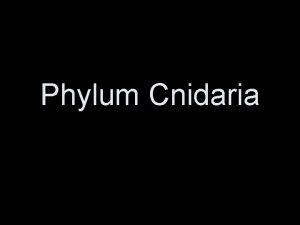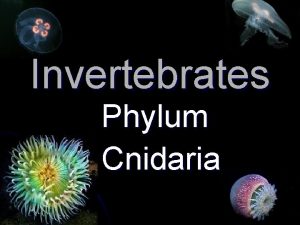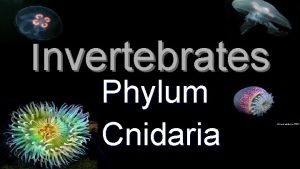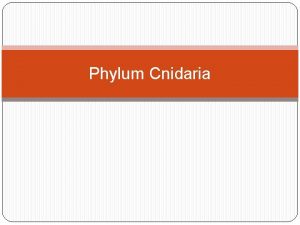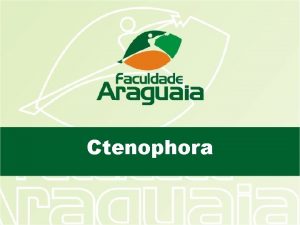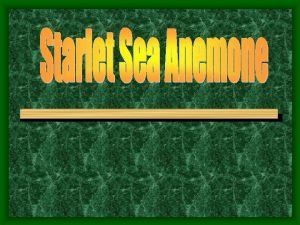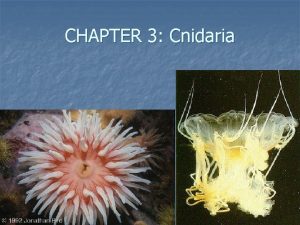Phylum Cnidaria Ctenophora Kingdom Animalia Phylum Cnidaria Class











































- Slides: 43

Phylum Cnidaria & Ctenophora Kingdom: Animalia Phylum Cnidaria Class Hydrozoa Class Scyphozoa Class Anthozoa Phylum Ctenophora

Major Characteristics o Also called Coelenterates o Cell-Tissue level of organization: Presence of specialized tissues o Two germ cell layers: Diploblastic o Body with two layers: epidermis and gastrodermis with mesoglea between the two

Major Characteristics o Have radial symmetry: oral and aboral ends o Two body forms polyps and medusa both with tentacles

Major Characteristics o Specialized stinging-cell organelles: cnidae o Tube with one hole: mouth, no true anus o Gastrovascular cavity present; digestion extracellular o Nerve net; no true nervous system

Major Characteristics o Sexual reproduction; monoecious or dioecious o Asexual reproduction by budding in polyps o No excretory or respiratory systems o No true muscular system but have epitheliomuscular cell that contract o Comprised of sea anemones, jellyfish, corals

Radial vs. Bilateral Symmetry Diagram A

Radial Symmetry

Two Main Body Forms - Polyp o A polyp is a sac like stage. o Sessile or non-motile

Two Main Body Forms Medusa o A medusa is bell-like, which is similar to an upside down swimming polyp o Free floating or swimming

Polyp vs. Medusa o Some spend their life as both at some point or as one or the other the entire time Diagram B

Polyp vs. Medusa Diagram D

Two Germ Layers:

Three Basic Layers o Ectoderm/Epidermis – outer layer that contains the stinging cells o Endoderm/Gastrodermis – lines the gut o Mesoglea – Jelly like substance in between the Ectoderm and Endoderm which contains scattered cells and collagen fibers NOT a true mesoderm layer

Exoskeleton o Coral will create a calcium carbonate shell in which it will live

Body Structure o The mouth is located on the top of the polyp or underside of the medusa o It is the only opening on the organism so is also shares the function of being an anus Diagram E

Body Structure Diagram F

Tentacles o Slender finger like structure used to capture and handle food

Cnidocytes o The main characteristic of Cnidaria is the presence of cnidocytes or stinging cells throughout the epidermis o Cnidocytes contain organelles called cnidae – 20 different kinds have been identified

Nematocysts o Coiled stinger with barbs and a filament attached o Spring into the prey and releases toxin o Most not harmful to humans because they cannot penetrate skin o Some fatal

Nematocysts

Nervous System o Main characteristic is the presence of a nerve net o Nerves cross over each other, at every connection, communication occurs o In humans millions cross over millions and no communication occurs

Nerve Net Diagram C

Cnidarian Nervous System

Digestive System o All cnidarians are carnivorous o Prey is paralyzed by the nematocysts o Enzymes in gastrovascular cavity break down the food and nutrients are absorbed by cells in the endoderm o Wastes are sent out the mouth/anus

Digestive System

Reproductive o Cnidarians have the ability to reproduce sexually and asexually o One asexual method that is commonly seen is budding

Class Anthozoa o Largest group of Cnidarians

Class Anthozoa (an-tho-zo'a) Name means “flower animal”. All polyps, no medusa. All marine, some colonial, some solitary. Found in deep, shallow, tropical and polar seas. Three different subclasses. Zoantharia – Sea anemones and hard corals Ceriantipatharia – Tube anemones and thorny corals Octocorallia – Soft and horny corals such as sea pens, sea fans, and sea pansies

Class Anthozoa Subclass Zoantharia Sea Anemones and Hard Corals

Class Anthozoa Subclass Ceriantipatharia Tube Anemones and Thorny Corals

Class Anthozoa Subclass Octocorallia Soft and horny corals Octocorallians are octomerous meaning they usually have an arrangement of eight tentacles arranged around the mouth.

Class Hydrazoa (hi-dro-zo'a) Name means “water serpent animal”. Most Hydrazoa live in marine environments and most also live in colonies. Some Hydrazoa are solitary and live in freshwater. Most commonly polyps reproduce asexually and medusa reproduce sexually Examples of genera include; Hydra, Obelia, Physalia,

Hydra and Obelia Hydra are freshwater cnidarians that are solitary and exist in the polyp body form Obelia often live in colonies and exist in both the polyp and medusa body form Solitary Hydra on left and Obelia colony on the right

Physalia (Portugese Man-of-War) Exist as both medusa and polyp forms. These Hydrazoans form floating colonies. The nematocysts secrete a powerful neurotoxin that can inflict painful stings. • This portugese man-ofwar is actually a colony of hydrazoans acting as one unit.

Class Scyphozoa (si-fo-zo'a) Name means “cup animal” Includes most of the common large jellyfish Solitary animals Scyphozoans are all marine Polyp stage is sometimes absent Scyphozoans have a bell-shaped medusa filled with an enlarged mesoglea and they lack a velum. The velum is a circular membrane surrounding the cap of a medusa that aids in swimming. Examples of Scyphozoans genera include; Aurelia, Cyanea, Cassiopeia, and Rhizostoma

Aurelia and Cyanea Aurelia on top “moon jellyfish”. Feeds on plankton caught in mucus on its umbrella Cyanea capillata on bottom. Called “Sea blubber” by fishermen. Aka Giant jellyfish or Lion's mane jellyfish) with a bell diameter of 2 meters and tentacles that can reach 60 - 70 meters long.

Class Cubozoa (ku'bo-zo'a) Name means a “cube-shaped animal”. All marine Solitary animals. Very little is known about the life cycle of cubozoans. Medusa are the primary body form. The bell-shaped medusa have a square or cube-shaped cross section. Examples of cubozoa include; Carybdea, Tripedalia, Chironex, and Chiropsalmus

Class Cubozoa Box Jellyfish (Carybdea marsupialis)

The Sea Wasp Box Jellyfish (Chironex fleckeri) Stings are very painful, dangerous and sometimes fatal. Found in the waters of Australia.

Phylum Ctenophora (te-nof'o-ra) Name means “comb bearing. ” Ctenophorans are called “comb jellies”. All marine, less than 100 species known. Live mostly in warm, tropical waters. Eight rows of comblike plates used for locomotion. Radial symmetry like Cnidarians. Most Ctenophores do not have nematocysts like Cnidarians. Instead they use sticky glue-like cells called colloblasts to capture prey. Comb jellies are also bioluminescent.

Ctenophora (Comb Jellies)

Cnidaria vs. Ctenophora o Have cilia at the base of the medusa to move o Engulf food o Do not have nematocysts o Have an additional layer between endo and ecto layers o Anal pore

Porifera and Cnidaria Lab o Observe each specimen at each station o Draw and label a diagram (at least ½ page) o Describe the appearance of the specimen along with the diagram o Sponges – label incurrent pores and oscula (plural for osculum) o Cnidarians – label mouth tentacles and body type (polyp or medusa) o Examine and Draw the Hydra budding wm label: tenticles, nematocyst and bud o Examine and Draw and label the Obelia slide
 Phylum cnidaria diagram
Phylum cnidaria diagram Kingdom animalia phylum cnidaria
Kingdom animalia phylum cnidaria Cnidocytes jellyfish
Cnidocytes jellyfish Family leporidae kingdom
Family leporidae kingdom Diptera phylum
Diptera phylum Section 33-2 review cnidaria and ctenophora answer key
Section 33-2 review cnidaria and ctenophora answer key Section 33-2 review cnidaria and ctenophora answer key
Section 33-2 review cnidaria and ctenophora answer key What are chordates
What are chordates Kingdom animalia phylum arthropoda
Kingdom animalia phylum arthropoda Kingdom animalia phylum chordata
Kingdom animalia phylum chordata Old kingdom middle kingdom new kingdom
Old kingdom middle kingdom new kingdom Nnn ruled
Nnn ruled Old kingdom middle kingdom new kingdom
Old kingdom middle kingdom new kingdom Mentohotep
Mentohotep Ctenophora
Ctenophora Is the science of naming and classifying organisms.
Is the science of naming and classifying organisms. Kingdom family genus
Kingdom family genus Domain, kingdom, phylum
Domain, kingdom, phylum Plant order classification
Plant order classification 8 levels of classification in order
8 levels of classification in order Horse taxonomy classification
Horse taxonomy classification What are the classifications of human?
What are the classifications of human? Classification of living things quickchek
Classification of living things quickchek Kingdom phylum class
Kingdom phylum class Neotenic meaning
Neotenic meaning Kingdom phylum class order of humans
Kingdom phylum class order of humans Kpcofgs
Kpcofgs Kingdom phylum class order
Kingdom phylum class order Bacteria kingdom phylum class order
Bacteria kingdom phylum class order Bacteria kingdom phylum class order
Bacteria kingdom phylum class order Sraep
Sraep Platypus class
Platypus class Pisces vertebrata
Pisces vertebrata Kingdom phylum class order family genus and species
Kingdom phylum class order family genus and species Domain kingdom phylum class order family genus species
Domain kingdom phylum class order family genus species Microorganisms importance
Microorganisms importance Taxonomy of squid
Taxonomy of squid Cow kingdom phylum class order
Cow kingdom phylum class order Levels of classification
Levels of classification Salmonella oxidase test
Salmonella oxidase test Cuttlefish phylum
Cuttlefish phylum Domain kingdom phylum class order
Domain kingdom phylum class order Compositeae
Compositeae Nine phyla of kingdom animalia
Nine phyla of kingdom animalia

